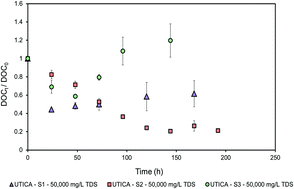Characterization and biological removal of organic compounds from hydraulic fracturing produced water†
Abstract
Hydraulic fracturing generates large volumes of produced water, and treatment of produced water may be necessary for disposal or reuse. Biological treatment of produced water is a potential approach to remove organic constituents and reduce fouling, in conjunction with other treatment processes. This study investigates the biological treatability of produced water samples from the Utica and Bakken Shales using engineered biofilms. Observed total dissolved organic carbon (DOC) removal varied between 1-87% at normalized total dissolved solids concentrations, suggesting that the composition of produced water, including organic constituents and trace elements such as nutrients and metals, is an important driver of biological treatment performance. Mass spectrometric analyses of the DOC composition revealed various alkanes in all samples, but differences in non-ionic surfactant, halogenated, and acidic compound content. Statistical data reduction approaches suggest that the latter two groups are correlated with reduced biodegradation kinetics. These results demonstrate that the combination of biodegradation performance and organic speciation can guide the assessment of the biological treatment of produced water.

- This article is part of the themed collection: The environmental geochemistry and biology of hydraulic fracturing


 Please wait while we load your content...
Please wait while we load your content...
